
Cymbidium, commonly known as boat orchids, is a genus of evergreen flowering plants in the orchid family Orchidaceae. Orchids in this genus are epiphytic, lithophytic, terrestrial or rarely leafless saprophytic herbs usually with pseudobulbs. There are usually between three and twelve leaves arranged in two ranks on each pseudobulb or shoot and lasting for several years. From one to a large number of flowers are arranged on an unbranched flowering stem arising from the base of the pseudobulb. The sepals and petals are all free from and similar to each other. The labellum is significantly different from the other petals and the sepals and has three lobes. There are about fifty-five species and sixteen further natural hybrids occurring in the wild from tropical and subtropical Asia to Australia. Cymbidiums are well known in horticulture and many cultivars have been developed.
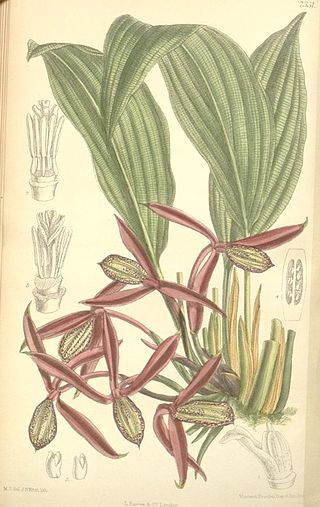
Orchidantha is a genus of flowering plants. In the APG III system, it is placed in the family Lowiaceae, as the sole genus. It includes the plants in the formerly recognised genera Lowia and Protamomum.
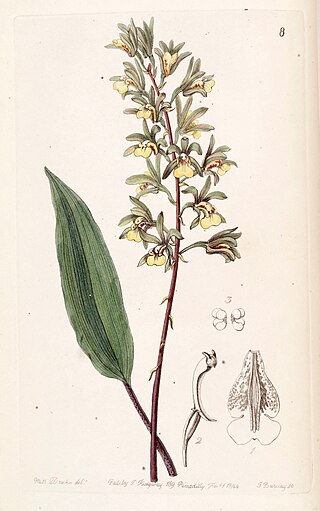
Tainia, commonly known as ribbon orchids or 带唇兰属 is a genus of about thirty species of evergreen, terrestrial orchids in the distributed from India, China, Japan, Southeast Asia to New Guinea, the Solomon Islands and Queensland.

Chroniochilus is a genus of flowering plants from the orchid family, Orchidaceae. It contains 5 species, native to Yunnan, Thailand, Malaysia and Indonesia.

Vrydagzynea, commonly called tonsil orchids, is a genus of orchids in the tribe Cranichideae. About forty five species of Vrydagzynea have been formally described. They are native to India, Taiwan, Southeast Asia, Malesia, Melanesia and Polynesia. A single species in Australia is possibly extinct. They have thinly textured, stalked leaves and small, dull-coloured resupinate flowers with the dorsal sepal and petals overlapping to form a hood over the column.

Pelatantheria is a genus of flowering plants from the orchid family, Orchidaceae. Its species are distributed across China, Japan, the Indian Subcontinent and Southeast Asia.
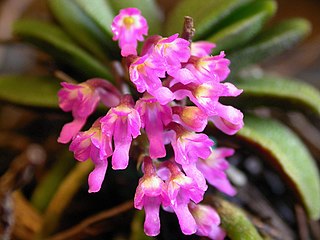
Schoenorchis, commonly known as flea orchids, or 匙唇兰属 in Chinese, is a genus of flowering plants from the orchid family, Orchidaceae. Plants in this genus are small epiphytes with thin roots, thin leafy stems with leaves in two ranks and tiny fragrant, almost tube-shaped flowers with a prominently spurred labellum. There are about twenty five species found from tropical and subtropical Asia to the Western Pacific.

Vanilla polylepis is a climbing orchid species in the plant family Orchidaceae. It is native to tropical Africa, with a range spanning the width of the continent, from Kenya to Angola. It grows in high-altitude evergreen and swamp forests between 1,200–1,500 m (3,900–4,900 ft) and is often found growing on trees bordering rivers and waterfalls. Plants produce bright green, fleshy stems, 10–12 mm (0.39–0.47 in) in diameter, with large, glossy leaves. White, aerial roots form on the stems allowing the orchids to attach themselves to trees for support. As with many orchids, they produce showy flowers, which in the case of V. polylepis are white and yellow with a pink to maroon blotch. This differentiates them from similar species. They have seedpod-like fruits, called capsules, which produce a distinctive aroma as they dry. They are closely related to the well-known species Vanilla planifolia, whose seed pods are used commercially in the production of vanilla flavouring.

Rhomboda, commonly known as velvet jewel orchids, is a genus of about twenty species of flowering plants in the orchid family Orchidaceae. Plants in this genus are mostly terrestrial herbs with a fleshy, creeping rhizome and a loose rosette of green to maroon coloured leaves. Small resupinate or partly resupinate, dull coloured flowers are borne on a hairy flowering stem. The dorsal sepal and petals overlap and form a hood over the column and there is a deep pouch at the base of the labellum. They are found in tropical regions from northern India through Southeast Asia, China, Japan to Australia and some Pacific Islands.

Corybas hatchii is a species of terrestrial orchid endemic to New Zealand. It has a solitary rounded leaf, often flecked with maroon, and a single pale green and maroon flower with long, threadlike lateral sepals and petals.

Pelatantheria insectifera is a species of orchid occurring in Thailand, Laos, India. The species is a long-stemmed epiphytic herb. The small flowers have a relatively large, fleshy, bright pink labellum. The specific epithet "insectifera", meaning "insect bearing", refers to the flowers, which are indicated to resemble an insect. Thus, attraction of pollinators by means of sexual deception is implied, but to date no pollinator has been published. The flowers are produced from September to October on subsessile racemes, which are shorter than the leaves. The plants are almost entirely self-incompatible, but a small percentage of self-pollination events may be successful. After pollination the colour of the labellum changes from pink to red and the sepals and petals begin to close.
Pelatantheria rivesii is a species of epiphytic or lithophytic orchid occurring in China, Laos and Vietnam. This species closely resembles Pelatantheria insectifera bothin its vegetative and generative morphology. The commonly branched stems may reach lengths of 1 m and diameters of 7 mm. Few flowers are produced during October on short racemes, which do not exceed the length of the leaves. The flowers are small and fleshy and the sepals and petals are pale yellow and bear striped. The labellum is pink.
Pelatantheria bicuspidata is a species of epiphytic or lithophytic orchid occurring in China and Thailand. This species closely resembles Pelatantheria ctenoglossum and Pelatantheria woonchengii. The specific epithet bicuspidata, derived from the Latin word bicuspidatus, meaning double pointed refers to the two pointed distal portion of the labellum. The stems are elongate, branched and bear elliptic-oblong, unequally bilobed, distichously arranged leaves. The flowers open widely and bear purple or red striations on petals and sepals. The labellum is fleshy, three-lobed and spurred at the base. The column bears tufted white hairs at its base.

Pelatantheria scolopendrifolia is a species of epiphytic or lithophytic orchid occurring in China, Japan and Korea. The plants closely adhere to the substrate and are creeping. The commonly branched, very slender stem bears distichously arranged, subcylindrical, leathery leaves. One to two widely opening flowers are produced on a short raceme, which is usually shorter than the leaves. The flowers are thinly textured and pale flesh-coloured. The labellum is spurred.
Pelatantheria woonchengii is a species of epiphytic or lithophytic orchid occurring in Vietnam, Thailand, Myanmar, and Malaysia. It may be easily misidentified as Pelatantheria ctenoglossum.
Pelatantheria cristata is a species of epiphytic or lithophytic orchid occurring in Indonesia, Thailand and Malaysia. It is similar to Pelatantheria insectifera and Pelatantheria rivesii. The stems may reach 20 cm in length and possess deflexed racemes up to 10 cm in length, bearing several flowers. The specific epithet cristata, derived from the Latin word cristatus, refers to the crested or tufted labellum.
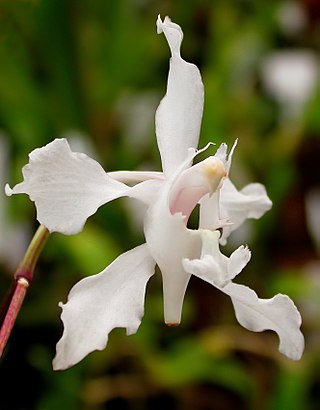
Papilionanthe vandarum is a species of epiphytic orchid native to India, China, Myanmar, and Nepal. It is closely related to Papilionanthe biswasiana.

Vanda dives is a species of epiphytic orchid native to Vietnam and Laos.
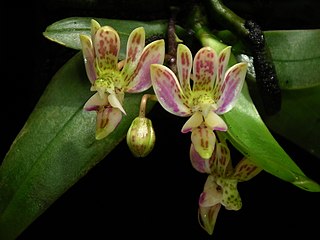
Phalaenopsis finleyi is a species of orchid native to Myanmar, Thailand and Vietnam.
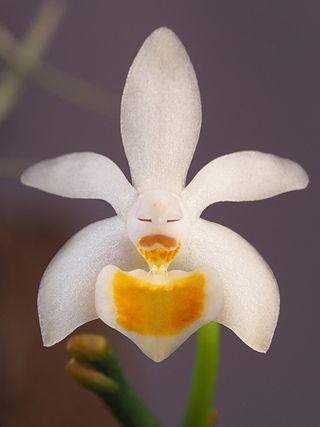
Phalaenopsis malipoensis, also known as 麻栗坡蝴蝶兰 in Chinese, is a species of orchid native to South-Central China and Vietnam. The specific epithet malipoensis refers to the Chinese locality Malipo, which is a hotspot for biodiversity research in Yunnan Province, China.














